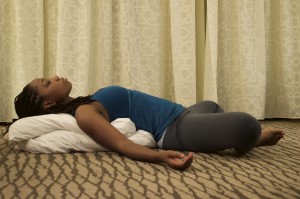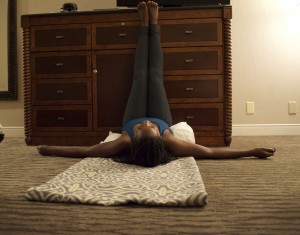Earlier this week, I shared that yoga has started to feel like work. I included a few motivational posters that I hope was helpful to all of you. After review that post, though, I didn’t feel like I truly helped so today, I’ve got a practice tip that may help to reignite the flame that can be lost when we feel like we’re striving with our practice. The tip is simply to take up restorative yoga.
I used to think that restorative yoga was a practice for those who were recovering from injury or trauma. The more that I learn about it, the more that I realized that it can be a truly beneficial addition to anyone’s practice–especially those of us who can’t muster to motivation needed to get through a vinyasa class.
Restorative yoga literally takes the physical work out of yoga by providing props that help you to relax into each pose. It’s a passive practice in which poses are held for several minutes. You can turn off the physical effort which is what most of us avoid when we’re tired or sick. Yet while your effort is turned off, you’re still improving your flexibility, focusing on your breathing, and calming your mind.
Doesn’t that sound lovely! It is. It’s also harder than you think. “Passive” only refers to what your body is doing. It is a serious brain workout to avoid stress, anxiety, and negative meditation while you’re laying in one position for ten minutes. Your challenge is to relax and let the practice do its work on you.
Restorative yoga may look like an extremely expensive practice at first. Google images for restorative yoga and you’ll see students practicing with tons of official-looking props like bolsters, eggs, blankets, eye masks, blocks, balls, and even small weighted pillows. While I’m sure these products are great, you don’t need them.
You can recreate the benefits of those props with items that you already have at home.
Try using:
- Bed pillows, throw pillows from your couch, and the cushions from your patio set offer different thicknesses and levels of support.
- Likewise, blankets, comforters, and duvets provide cushion and support and can fold to mold to the body.
- Use a wash cloth or hand towel as an eye mask. When folded, both items block most light and still add a gentle pressure to your eyes. Once damp, you can also heat or cool the cloths depending on what you prefer.
- A stack of magazines or paperback books work well in place of blocks. Avoid using hardcover books since they don’t have as much give. You won’t need to move the stacks often, like in a vinyasa class, so mobility is less of an issue.
First time practicing? These are a few of my favorite restorative yoga poses.
Supported Child’s Pose – Balasana
Gently opens shoulders, upper and lower back, as well as the hips and knees. Excellent for those of us who stand a lot at work.
Reclining Bound Angle Pose – Supta Baddha Konasana
Gently opens chest, hips, and inner thighs. It’s one of my faves after long days sitting at the computer.
Legs Up the Wall Pose
This inversion gently stretches the hamstrings, calves, and lower back. Getting into it can be awkward, so I recommend positioning your support pillows first (near your sacrum) and then rolling onto the pillows from the side.
These are just a few restorative yoga asanas that can help you maintain the consistency and benefits of your practice even when you’ve hit a slump. For more, check out Kyle Anne’s RestorativeYoga.com.


